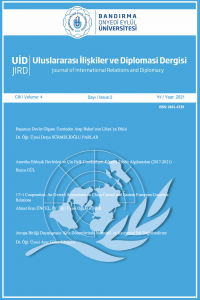Research Article
Aim & Scope
Bandırma
Onyedi Eylül University Journal of International Relations and
Diplomacy aims to publish high-quality research articles that can
contribute to the scientific world with the fields of international
relations, diplomacy, economics, basic sciences and social sciences,
politics, economics, economics-politics, diplomacy applications,
political history, international treaties, international organizations,
law, international law.
The journal started its publication life in 2018 and began to be
published electronically. Journal of International Relations and
Diplomacy is a peer-reviewed and periodical journal published twice a
year (in March and October) since 2018. Bandırma Onyedi Eylül
University, Faculty of Economics and Administrative Sciences, the
Journal of International Relations and Diplomacy, may issue additional
issues or special issues in some periods. The journal publishes research
articles in Turkish and English languages and assigns a DOI number to
all published articles.
The manuscripts submitted to our journal
for review should not be previously published, accepted for
publication, and should not be in the process of being evaluated for
release. The responsibility of the published and published works belongs
to the author (s). Our issues are published electronically. The
copyright of the published works belongs to the Journal of International
Relations and Diplomacy.
The studies to be published can be
prepared and submitted following the conditions specified in the journal
writing rules and publication principles. The articles submitted to the
journal are subject to a preliminary examination in terms of form and
content. The articles that are found suitable in terms of form and
content are submitted to the editorial board to be appointed as
referees. There is no guarantee that the articles submitted to the
journal will be included in the arbitration process. After the
evaluation process, the arbitration process lasts between 4 and 8 weeks.
At least two reviewers are appointed if the articles reviewed by the
Editorial Board are found appropriate. Under the reports coming from the
referees, it is decided that the article should be published and that
the author (s) should request correction, additional information, and
abbreviations from the author (s) or not. In case a positive and
negative report is given by the referees, the related work is sent to a
third referee if deemed appropriate by the Journal Editor.
Author Guidelines
PUBLICATION GUIDELINES.
1. The manuscripts sent to the JIRD should not have been published anywhere before and should not be available for publication at the present time.
2. Manuscripts from any of the languages of Turkish and English is published in JIRD. Scientific and linguistic responsibility for the manuscript published in the JIRD belongs to the author(s)
3. Manuscripts will be evaluated not only by academicians, but also by researchers and practitioners.
4. Manuscripty that has been previously presented at conferences and has not been published in full proceeding but only the abstract can be accepted into the publication evaluation process as indicated in the study.
5. Submissions of Manuscripts should be sent electronically via dergipark.gov.tr/journaleess. To be able to submit the articles online through the website and to track the process of the manuscripts during the referee evaluation process, membership to dergipark and login should be made.Personal information registered into the site of JIRD will only be used for the stated purpose of the journal and will not be accessible for any other purpose or for any other party.
6. Articles sent to JIRD are available to the authors through the dergipark manuscript submission system and the evaluation reports can be easily followed by the authors through there.
7. Manuscript file will be uploaded to the system without author information during submission. Author information should be uploaded as a separate file with the name of the article in the form of identification. Identification file should include ORCID Number(s) of Author(s). Submission should be in Microsoft Word Format. Submissions do not comply with the Journal Rules are not included in the evaluation process. In Articles ready for publication, the author names should be written on the right under Heading in Turkish, 11 Font size, Bold, Title and Surname UPPERCASE. The copyright information of author(s) should be added to the bottom of the first page in 9 font size with star(*) footnotes.
8. JIRD is based on the principle of not knowing the author(s) (blind-review). Manuscripts submitted to the referee, information about the author's identity is kept secret.
9. Articles submitted to the JIRD are sent to at least two remarks for blind-review after preliminary examination in terms of form and content. Positive feedback from the referees is taken to the publishing process. If a positive and a negative report is received from the blind-review process, a third trial will be sent if it is deemed appropriate by the Journal Editor.
10. Author(s) who submitted articles to JIRD are deemed to have accepted the terms and conditions of the referee evaluation of the JIRD.
11. Article(s) do not comply with the rules of spelling or linguistic information are returned to the author(s) without being sent to the referees in the JIRD after the preliminary examination. Any form and content changes may be requested from the authors of the preliminary examination.
12. During layout work, the author(s) must respond to the checks and corrections made during the specified period. The author (s) who do not respond within the specified period will be postponed to be evaluated at the next issue.
13. Assessment process completed articles are listed as of the date of submission and published in the relevant issue of JIRD. Acceptance letter is sent to the authors for the accepted articles in case of request. Same author(s) will not publish two articles in one issue at a time.
14. JIRD publishes translations outside of the original research. The copy showing where the translation has been published should be sent as a supplement to the manuscript with the approval of the author(s) and the manuscript of the first publication.
15. In the direction of the reports from the blind-reviews, it is decided whether or not the author is required to make corrections, additional information and abbreviations in the report frame or publishing the articles. This decision is reported to the author(s) through the system. The author(s) have to make all changes requested by the referees. Articles will not be published until the desired changes are made.
16. All the publications accepted and published in JIRD, the publishing rights in the written and electronic environment belong to JIRD.
17. No copyright payments are made to author(s) for articles published in JIRD. Regarding the articles accepted or published, the author(s) shall transfer the copyright directly to JIRD without any procedure.
18. Opinions expressed in the editorial and the responsibility of articles belong to the authors.
19. Articles accepted or published for publication may not be reproduced or published in any form without written permission of JIRD. Quotation is allowed as long as a citation is provided.
20. It is not possible for the author(s) to withdraw the submission sent to JIRD during referee process and to cancel to initiate the referee process, nor does it conform to scientific ethics. Taking this fact into consideration by the authors when submitting a manuscripts will also prevent the academic ethical grievances of the parties with possible work and time loss.
21. If the research article or manuscript is supported by an institution or is produced from a thesis, it should be indicated on the same page as a footnote (1) on the last word of the title.
AUTHOR GUIDELINES:
Font Type and Page Layout;
1. Manuscripts submitted to the journal should have a maximum of 20 A4 pages with 1,5-line spacing including bibliographies, tables and figures. The manuscript should be prepared in 11 fontsize, Times New Roman font and English language font. Space between each paragraph (after 6 nk) must be left blank. The number of pages of the manuscript may exceed the upper limit after corrections demands from the blind reviewers with publication page layouts, citation, logo and similar arrangements.
2. For each side of the page structure (right-left, top-bottom) the margins should be 2.5 cm. Page numbers should be located at the bottom right corner of the page
Main Body;
3. The author information includes the manuscript file on the first page; English title, English abstract, keywords under the abstracts, JEL Classification Codes and the Introduction should be composed of main text, results, bibliography and appendices.
Title of Article;
4. Titles should be typed in Times New Roman, 11 fontsize and bold, with a capital letter, centered on the abstract section, with 1.5 pt line spacing.
Abstract, Keywords & JEL Classification
5. All submitted manuscripts should have an abstract in English with Italic fonts. Keywords should be in English below the abstracts. The first letter of the key words should be Uppercase, left-aligned with the JEL codes. Abbreviation should not be used in the abstracts and should not exceed 150 words. Also in abstract section, attention should be paid to the inclusion of purpose, method, findings and conclusions.
6. At least three (3) JEL (Journal of Economic Literature) classification codes should be written on the two-digit level (eg Q11) in the submitted manuscripts. For JEL classifications that should be selected according to the topic of the manuscript, please refer to http://www.aeaweb.org/journal/jel_class_system.php .
7. Abstracts, Keywords and JEL codes should be in Times New Roman, 11 pt, 1.5 line spacing, italicized. Only the titles of these sections should be bold.
Main Body & Section Heading;
8. The main body of manuscripts should be written as 11 pt, 1,5 line spaced and justified using Times New Roman font. The first lines of paragraphs indentation should be 1 cm. Main title and subheadings of manuscripts should be numbered and bold, starting from the Introduction (except references), in decimal form as in 1, 1.1, 1.1.1. Subdivisions should be opened up to the third level (such as 1.2.3.) in manuscripts, and if necessary, the lower level headings should be written in italic and bold without numbering. The heading must be left-justified with the first heading number associated with this heading, and the subheadings associated with this heading indentation must be 1 cm from the numbering. Only main titles should be written in capital letters, and only the first letter of sub headings should be Uppercase. 12 nk before, then 6 nk lining space should be left for each Main Titles. 6 nk lining space should be left for each paragraph.
Tables, Figures & Graphs;
9. Tables, figures and charts should be displayed consecutively (Table 1, Table2, Figure 1, Figure 2, Chart 1, Chart 2) in appropriate place of the manuscripts, centered on the page. Each table, figure or chart should be given a caption. The caption must appear on the table, figure or chart, with Times New Roman, 11 pt, bold, centered on the page. A table, figure or graphic caption name should be written with a single dot after it is given together with a writing number of the table, figure or graphic. The lining space of the table, figure or chart caption should be (after 6 nk). Tables, Figures or Charts can also be used horizontally if needed. The text in the table, figure and chart should be in 10 pt fontsize and 9 pt fontsize for reference of table, figure or chart.
10. The tables should be used with output of the software program, the author(s) should edit the tables and results themselves. Tables should be arranged as far as possible for A4 paper size. Shapes shouldn't be computer software program output, should be drawing and not exceeding A4 paper size.
Mathematical Equations & Formulas;
11. Mathematical equations and formulas in main body should be centered and ordered by number. Numbering should be done in parenthetical at the right of the line. Formulas and Equations should be written via Math Type or Word Equation Editor.
In-text Referencing;
12. Citation should be made in accordance with the APA (American Psychological Association) reference format using link method in the main body. Explanatory notes should be given as footnote 9 pt font size at the bottom of the page(Each footnote should be 9 pt as well). Sources in main body should include the surname, publication date, and page number of the author(s) who is/are included in the article. For instance, (Çetinoğlu, 2002)...; (Çetin, 2002: 182)...; (Eliçin, 2001: 182-186). If the author(s) surname is/are used in the sentence, it is sufficient to post the publication date only in parentheses after the name. For instance, According to Özer and Birkan(2000)...; According to Birtan(2007)...; Özer and Birkan (2004)...; Özkul, Biran and Akın (2004). Both authors surname should be written if referenced to two authors studies. For Instance; (Yamak and Maraş, 2009: 47). If referring to a study for the first time with the number of authors is between three and five, the surnames of all authors should be written. For Instance, (Özkul, Uzun, Güzel, Özer and Soysal, 1992: 154-198). In later references to the same source, only the first author's surname and "et al." should be written. For Instance (Özkul et al., 1992: 154-198). When referring to a study with six or more authors, the surname of the first author should be written in the first place and the next citation in the text, and the expression "et al."should be used. For Instance (Özkul et al., 2005: 154-198). If the author(s) refer to more than one work published in the same year, symbols (a, b, c, ..) should be written at the end of the publication year. For instance (Darıcı, 2015a) or (Darıcı, 2015b: 125). If referring more than one study at the end of a sentence hese sources should be listed parenthetical according to the publication date and a semicolon (;) must be placed between them. For instance, (Bozok, 2009, Mert, 2008: 25, Özer and others, 2005, Vahitoglu, Gürler and Özdağ, 2003: 61). If there is no author name, the institution name should be used instead of author. (DPT, 2004: 32). For Internet resources date of access should be written. (TUBITAK; 23.04.2015)
Bibliography (References)
14. References should be placed in alphabetical order by considering the surnames of the authors and at the end of the article in 11 pt. Paragraph spacing between each reference should be before and after (6 pt). If more than one study of the author (s) has been used in the same year, these works should be listed in front of the year of publication like (a, b, c, ..). The bibliography should be organized as shown below
(i) Reference to a book:
Stopford, M. (1997). Maritime Economics. New York: Routledge.
(ii) Translated book:
Davison, A. (2006). Türkiye’de Sekülerizm ve Modernlik. Tuncay Birkan (Trans.). İstanbul: İletişim Yayınları.
(iii) Reference to a chapter in an edited book:
Esen, Ö., & Aydın, C. (2018). Tunisia. In: S. Özdemir, S. Erdoğan, & A. Gedikli (Eds.), Handbook of Research on Sociopolitical Factors Impacting Economic Growth in Islamic Nations (pp. 68-94). USA: IGI Global.
(iv) Reference to a journal publication:
Esen, Ö. (2016). Security of the energy supply in Turkey: Prospects, challenges and opportunities. International Journal of Energy Economics and Policy, 6(2), 281-289
(v) Two authors:
Aydin, C., & Esen, Ö. (2018). Does the level of energy intensity matter in the effect of energy consumption on the growth of transition economies? Evidence from dynamic panel threshold analysis. Energy Economics, 69, 185-195.
(vi) Theses and dissertations:
Esen, Ö. (2013). Sürdürülebilir Büyüme Bağlamında Türkiye’nin Enerji Açığı Sorunu: 2012-2020 Dönemi Enerji Açığı Projeksiyonu. Doctoral Dissertation. Erzurum: Atatürk University.
(vii) Internet Based Sources
IATA (2016). Annual Reports Review. (15.10.2017), Retrieved from https://www.iata.org/about/Documents/iata-annual-review-2016.pdf
(vii) Symposium or Congress Presentation
Darıcı, B.
(2018). Ekolojik Ayakizi ile Reel Gelir Arasındaki İlişki.
International Conference on Empirical Economics Social Sciences,
Bandırma-Balıkesir.
(ix)
Official Document, statement etc.
DPT (2003). Ekonomik Rapor.DPT Yayınları No: 2003-77, Ankara.
Ethical Principles and Publication Policy
Yayın Etiği ve Yayın Politikası
Aşağıda yer alan etik görev ve sorumluluklar oluşturulurken açık erişim olarak Committee on Publication Ethics (COPE) tarafından yayınlanan rehberler ve politikalar dikkate alınarak hazırlanmıştır.
Yazarların Etik Sorumlulukları
Uluslararası İlişkiler ve Diplomasi Dergisine çalışma gönderen yazar(lar)ın aşağıdaki etik sorumluluklara uyması beklenmektedir;
Uluslararası İlişkiler ve Diplomasi Dergisi'nde uygulanan yayın süreçleri, bilginin tarafsız ve saygın bir şekilde gelişimine ve dağıtımına temel teşkil etmektedir. Bu doğrultuda uygulanan süreçler, yazarların ve yazarları destekleyen kurumların çalışmalarının kalitesine doğrudan yansımaktadır. Hakemli çalışmalar bilimsel yöntemi somutlaştıran ve destekleyen çalışmalardır. Bu noktada sürecin bütün paydaşlarının (yazarlar, okuyucular ve araştırmacılar, yayıncı, hakemler ve editörler) etik ilkelere yönelik standartlara uyması önem taşımaktadır. Uluslararası İlişkiler ve Diplomasi Dergisi yayın etiği kapsamında tüm paydaşların aşağıdaki etik sorumlulukları taşıması beklenmektedir.
Yazar(lar)ın gönderdikleri çalışmaların özgün olması beklenmektedir. Yazar(lar)ın başka çalışmalardan yararlanmaları veya başka çalışmaları kullanmaları durumunda eksiksiz ve doğru bir biçimde atıfta bulunmaları ve/veya alıntı yapmaları gerekmektedir.
Çalışmanın oluşturulmasında içeriğe entelektüel açıdan katkı sağlamayan kişiler, yazar olarak belirtilmemelidir.
Yayınlanmak üzere gönderilen tüm çalışmaların varsa çıkar çatışması teşkil edebilecek durumları ve ilişkileri açıklanmalıdır.
Yazar(lar)dan değerlendirme süreçleri çerçevesinde makalelerine ilişkin ham veri talep edilebilir, böyle bir durumda yazar(lar) beklenen veri ve bilgileri yayın kurulu ve bilim kuruluna sunmaya hazır olmalıdır.
Yazar(lar) kullanılan verilerin kullanım haklarına, araştırma/analizlerle ilgili gerekli izinlere sahip olduklarını veya deney yapılan deneklerin rızasının alındığını gösteren belgeye sahip olmalıdır.
Yazar(lar)ın yayınlanmış, erken görünüm veya değerlendirme aşamasındaki çalışmasıyla ilgili bir yanlış ya da hatayı fark etmesi durumunda, dergi editörünü veya yayıncıyı bilgilendirme, düzeltme veya geri çekme işlemlerinde editörle işbirliği yapma yükümlülüğü bulunmaktadır.
Yazarlar çalışmalarını aynı anda birden fazla derginin başvuru sürecinde bulunduramaz. Her bir başvuru önceki başvurunun tamamlanmasını takiben başlatılabilir. Başka bir dergide yayınlanmış çalışma Uluslararası İlişkiler ve Diplomasi Dergisi'ne gönderilemez.
Değerlendirme süreci başlamış bir çalışmanın yazar sorumluluklarının değiştirilmesi (Yazar ekleme, yazar sırası değiştirme, yazar çıkartma gibi) teklif edilemez.
Editörlerin Etik Görev ve Sorumlulukları
Uluslararası İlişkiler ve Diplomasi Dergisi editör ve alan editörleri, açık erişim olarak Committee on Publication Ethics (COPE) tarafından yayınlanan "COPE Code of Conduct and Best Practice Guidelines for Journal Editors" ve "COPE Best Practice Guidelines for Journal Editors" rehberleri temelinde aşağıdaki etik görev ve sorumluluklara sahip olmalıdır:
Genel görev ve sorumluluklar
Editörler, Yönetim ve Uluslararası İlişkiler ve Diplomasi Dergisi'nde yayınlanan her yayından sorumludur. Bu sorumluluk bağlamında editörler, aşağıdaki rol ve yükümlülükleri taşımaktadır:
Okuyucuların ve yazarların bilgi ihtiyaçlarını karşılamaya yönelik çaba sarf etme,
Sürekli olarak derginin gelişimini sağlama,
Dergide yayınlanan çalışmaların kalitesini geliştirmeye yönelik süreçleri yürütme,
Düşünce özgürlüğünü destekleme,
Akademik açıdan bütünlüğü sağlanma,
Fikri mülkiyet hakları ve etik standartlardan taviz vermeden iş süreçlerini devam ettirme,
Düzeltme, açıklama gerektiren konularda yayın açısından açıklık ve şeffaflık gösterme.
Okuyucu ile ilişkiler
Editörler tüm okuyucu, araştırmacı ve uygulayıcıların ihtiyaç duydukları bilgi, beceri ve deneyim beklentilerini dikkate alarak karar vermelidir. Yayınlanan çalışmaların okuyucu, araştırmacı, uygulayıcı ve bilimsel literatüre katkı sağlamasına ve özgün nitelikte olmasına dikkat etmelidir. Ayrıca editörler okuyucu, araştırmacı ve uygulayıcılardan gelen geri bildirimleri dikkate almak, açıklayıcı ve bilgilendirici geri bildirim vermekle yükümlüdür.
Yazarlar ile ilişkiler
Editörlerin yazarlara karşı görev ve sorumlulukları aşağıdaki şekildedir:
Editörler, çalışmaların önemi, özgün değeri, geçerliliği, anlatımın açıklığı ve derginin amaç ve hedeflerine dayanarak olumlu ya da olumsuz karar vermelidir.
Yayın kapsamına uygun olan çalışmaların ciddi problemi olmadığı sürece ön değerlendirme aşamasına almalıdır.
Editörler, çalışma ile ilgili ciddi bir sorun olmadıkça, olumlu yöndeki hakem önerilerini göz ardı etmemelidir.
Yeni editörler, çalışmalara yönelik olarak önceki editör(ler) tarafından verilen kararları ciddi bir sorun olmadıkça değiştirmemelidir.
"Kör Hakemlik ve Değerlendirme Süreci" mutlaka yayınlanmalı ve editörler tanımlanan süreçlerde yaşanabilecek sapmaların önüne geçmelidir.
Yazarlara açıklayıcı ve bilgilendirici şekilde bildirim ve dönüş sağlanmalıdır.
Hakemler ile ilişkiler
Editörlerin hakemlere karşı görev ve sorumlulukları aşağıdaki şekildedir:
Hakemleri çalışmanın konusuna uygun olarak belirlemelidir.
Hakemlerin değerlendirme aşamasında ihtiyaç duyacakları bilgi ve rehberleri sağlamakla yükümlüdür.
Yazarlar ve hakemler arasından çıkar çatışması olup olmadığını gözetmek durumundadır.
Körleme hakemlik bağlamında hakemlerin kimlik bilgilerini gizli tutmalıdır.
Hakemleri tarafsız, bilimsel ve nesnel bir dille çalışmayı değerlendirmeleri için teşvik etmelidir.
Hakemlerin performansını artırıcı uygulama ve politikalar belirlemelidir.
Hakem havuzunun dinamik şekilde güncellenmesi konusunda gerekli adımları atmalıdır.
Nezaketsiz ve bilimsel olmayan değerlendirmeleri engellemelidir.
Hakem havuzunun geniş bir yelpazeden oluşması için adımlar atmalıdır.
Yayın kurulu ile ilişkiler
Editörler, tüm yayın kurulu üyelerinin süreçleri yayın politikaları ve yönergelere uygun ilerletmesini sağlamalıdır. Yayın kurulu üyelerini yayın politikaları hakkında bilgilendirmeli ve gelişmelerden haberdar etmelidir. Ayrıca editörler;
Yayın kurulu üyelerinin çalışmaları tarafsız ve bağımsız olarak değerlendirmelerini sağlamalıdır.
Yeni yayın kurulu üyelerini, katkı sağlayabilir ve uygun nitelikte belirlemelidir.
Yayın kurulu üyelerinin uzmanlık alanına uygun çalışmaları değerlendirme için göndermelidir.
Yayın kurulu ile düzenli olarak etkileşim içerisinde olmalıdır.
Yayın kurulu ile belirli aralıklarla yayın politikalarının ve derginin gelişimi için toplantılar düzenlemelidir.
Dergi sahibi ve yayıncı ile ilişkiler
Editörler ve yayıncı arasındaki ilişki editoryal bağımsızlık ilkesine dayanmaktadır. Editörler ile yayıncı arasında yapılan yazılı sözleşme gereği, editörlerin alacağı tüm kararlar yayıncı ve dergi sahibinden bağımsızdır.
Editoryal ve kör hakemlik süreçleri
Editörler; dergi yayın politikalarında yer alan "Kör Hakemlik ve Değerlendirme Süreci" politikalarını uygulamakla yükümlüdür. Bu bağlamda editörler her çalışmanın adil, tarafsız ve zamanında değerlendirme sürecinin tamamlanmasını sağlar.
Kalite güvencesi
Editörler; dergide yayınlanan her makalenin dergi yayın politikaları ve uluslararası standartlara uygun olarak yayınlanmasından sorumludur.
Kişisel verilerin korunması
Editörler; değerlendirilen çalışmalarda yer alan deneklere veya görsellere ilişkin kişisel verilerin korunmasını sağlamakla yükümlüdür. Çalışmalarda kullanılan bireylerin açık rızası belgeli olmadığı sürece çalışmayı reddetmekle görevlidir. Ayrıca editörler; yazar, hakem ve okuyucuların bireysel verilerini korumaktan sorumludur.
Etik kurul, insan ve hayvan hakları
Editörler; değerlendirilen çalışmalarda insan ve hayvan haklarının korunmasını sağlamakla yükümlüdür. Çalışmalarda kullanılan deneklere ilişkin etik kurul onayı, deneysel araştırmalara ilişkin izinlerin olmadığı durumlarda çalışmayı reddetmekle sorumludur.
Olası suistimal ve görevi kötüye kullanmaya karşı önlem
Editörler; olası suistimal ve görevi kötüye kullanma işlemlerine karşı önlem almakla yükümlüdür. Bu duruma yönelik şikâyetlerin belirlenmesi ve değerlendirilmesi konusunda titiz ve nesnel bir soruşturma yapmanın yanı sıra, konuyla ilgili bulguların paylaşılması editörün sorumlulukları arasında yer almaktadır.
Akademik yayın bütünlüğünü sağlamak
Editörler çalışmalarda yer alan hata, tutarsızlık ya da yanlış yönlendirme içeren yargıların hızlı bir şekilde düzeltilmesini sağlamalıdır.
Fikri mülkiyet haklarının korunması
Editörler; yayınlanan tüm makalelerin fikri mülkiyet hakkını korumakla, olası ihlallerde derginin ve yazar(lar)ın haklarını savunmakla yükümlüdür. Ayrıca editörler yayınlanan tüm makalelerdeki içeriklerin başka yayınların fikri mülkiyet haklarını ihlal etmemesi adına gerekli önlemleri almakla yükümlüdür.
Yapıcılık ve tartışmaya açıklık
Editörler;
Dergide yayınlanan eserlere ilişkin ikna edici eleştirileri dikkate almalı ve bu eleştirilere yönelik yapıcı bir tutum sergilemelidir.
Eleştirilen çalışmaların yazar(lar)ına cevap hakkı tanımalıdır.
Olumsuz sonuçlar içeren çalışmaları göz ardı etmemeli ya da dışlamamalıdır.
Şikayetler
Editörler; yazar, hakem veya okuyuculardan gelen şikayetleri dikkatlice inceleyerek aydınlatıcı ve açıklayıcı bir şekilde yanıt vermekle yükümlüdür.
Politik ve Ticari kaygılar
Dergi sahibi, yayıncı ve diğer hiçbir politik ve ticari unsur, editörlerin bağımsız karar almalarını etkilemez.
Çıkar çatışmaları
Editörler; yazar(lar), hakemler ve diğer editörler arasındaki çıkar çatışmalarını göz önünde bulundurarak, çalışmaların yayın sürecinin bağımsız ve tarafsız bir şekilde tamamlamasını garanti eder.
Hakemlerin Etik Sorumlulukları
Tüm çalışmaların "Körleme Hakemlik" ile değerlendirilmesi yayın kalitesini doğrudan etkilemektedir. Bu süreç yayının nesnel ve bağımsız değerlendirilmesi ile güven sağlar. Uluslararası İlişkiler ve Diplomasi Dergisi değerlendirme süreci çift taraflı kör hakemlik ilkesiyle yürütülür. Hakemler yazarlar ile doğrudan iletişime geçemez, değerlendirme ve yorumlar dergi yönetim sistemi aracılığıyla iletilir. Bu süreçte değerlendirme formları ve tam metinler üzerindeki hakem yorumları editör aracılığıyla yazar(lar)a iletilir. Bu bağlamda Uluslararası İlişkiler ve Diplomasi Dergisi için çalışma değerlendiren hakemlerin aşağıdaki etik sorumluluklara sahip olması beklenmektedir:
Sadece uzmanlık alanı ile ilgili çalışma değerlendirmeyi kabul etmelidir.
Tarafsızlık ve gizlilik içerisinde değerlendirme yapmalıdır.
Değerlendirme sürecinde çıkar çatışması ile karşı karşıya olduğunu düşünürse, çalışmayı incelemeyi reddederek, dergi editörünü bilgilendirmelidir.
Gizlilik ilkesi gereği inceledikleri çalışmaları değerlendirme sürecinden sonra imha etmelidir. İnceledikleri çalışmaların sadece nihai versiyonlarını ancak yayınlandıktan sonra kullanabilir.
Değerlendirmeyi nesnel bir şekilde sadece çalışmanın içeriği ile ilgili olarak yapmalıdır. Milliyet, cinsiyet, dini inançlar, siyasal inançlar ve ticari kaygıların değerlendirmeye etki etmesine izin vermemelidir.
Değerlendirmeyi yapıcı ve nazik bir dille yapmalıdır. Düşmanlık, iftira ve hakaret içeren aşağılayıcı kişisel yorumlar yapmamalıdır.
Değerlendirmeyi kabul ettikleri çalışmayı zamanında ve yukarıdaki etik sorumluluklarda gerçekleştirmelidir.
Yayıncının Etik Sorumlukları
Uluslararası İlişkiler ve Diplomasi Dergisi Editörleri ve Yayın Kurulu aşağıdaki etik sorumlulukların bilinciyle hareket etmektedir:
Editörler, Uluslararası İlişkiler ve Diplomasi Dergisi'ne gönderilen çalışmaların tüm süreçlerinden sorumludur. Bu çerçevede ekonomik ya da politik kazançlar göz önüne alınmaksızın karar verici kişiler editörlerdir.
Bağımsız editör kararı oluşturulmasını taahhüt eder.
Uluslararası İlişkiler ve Diplomasi Dergisi'nde yayınlanmış her makalenin mülkiyet ve telif hakkını korur ve yayınlanmış her kopyanın kaydını saklama yükümlüğünü üstlenir.
Editörlere ilişkin her türlü bilimsel suistimal, atıf çeteciliği ve intihalle ilgili önlemleri alma sorumluluğuna sahiptir.
Etik Olmayan Bir Durumla Karşılaşırsanız;
Uluslararası İlişkiler ve Diplomasi Dergisi'nde yukarıda bahsedilen etik sorumluluklar ve dışında etik olmayan bir davranış veya içerikle karşılaşırsanız lütfen agunar@bandirma.edu.tr adresine e-posta yoluyla bildiriniz.
Indexes
Other Indexes
Journal Boards
Editor in Chief

Editorial Board

Publication Board


Secretariat

Advisory Borad
Dr. Oxana Kharitonova joined the School of Political Science at MGIMO University as a PhD student in 1991. Since 1995 she has taught at the Department of Comparative Politics where currently holds the post of Associate Professor. She holds M.A. in Global development and social justice (ST.John's University) and Ph.D. in political institutions and process (MGIMO university).
Advisory Borad
Dr. Oxana Kharitonova joined the School of Political Science at MGIMO University as a PhD student in 1991. Since 1995 she has taught at the Department of Comparative Politics where currently holds the post of Associate Professor. She holds M.A. in Global development and social justice (ST.John's University) and Ph.D. in political institutions and process (MGIMO university).

Political Science Department - Independent Researcher
https://newbulgarian.academia.edu/Todor_Kondarev
Research interests: European Union, European studies, European Union integration, European Union politics, Economics of the European Union, EU Law, History of the European Union, European Union Citizenship, EU external relations, European Union Environmental Policy, Analysis of the social and economic policy of the European Union to third countries, International relations of the European Union.

Olivier Costa is a political scientist and CNRS research professor at CEVIPOF, the Centre for Political Research at Sciences Po (Paris). His research focuses on the institutional system and policies of the European Union, the institutions and players involved in parliamentary representation, and democracy. He is the author of 10 books, has edited 25 books and special issues of journals, and has published 200 scientific articles, chapters in collective books and reports.
He teaches European affairs at Sciences Po. He has been a visiting professor at numerous universities in Europe, the United States and Japan. He is also involved in lifelong training on European issues for a variety of audiences. He works as an expert for the European Parliament, the European Commission, the French authorities and think tanks.
More info: www.olivier-costa.com









